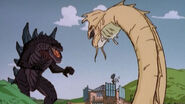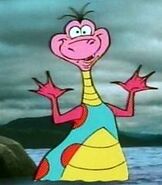| Loch Ness Monster | |||
|---|---|---|---|

| |||
| Naming | |||
| Others | Nessie | ||
| Binomen | Nessiteras rhombopteryx | ||
| Original | Niseag | ||
| Morphology | |||
| Body type | Plesiosaurine | ||
| Average height | Uncertain | ||
| Average length | Uncertain | ||
| Average weight | Uncertain | ||
| Intelligence | |||
| Sentience | Sentient | ||
| Sapience | Non-Sapient (most likely) | ||
| Ecology | |||
| Place of origin | Scotland Highlands | ||
| Habitat | Freshwater | ||
| Diet | Uncertain | ||
| Locomotion | Swimming Crawling on land (sometimes) | ||
| Lifespan | Uncertain | ||
| Status | DD | ||
| Behind the Scenes | |||
| Universe | Real | ||
The Loch Ness Monster (a.k.a. Nessie for short) is a large, unidentified animal species believed to inhabit Loch Ness in Scotland. Its size and appearance varies from report to report, usually taking the appearance of a seal-shaped animal with a long, serpentine neck. Early encounters also described it as a prehistoric beast, a dragon or a lake serpent. Although spotted by countless witnesses since historical times, concrete evidence for the monster's veracity remains scarce. Mostly, it has been documented in photographs, video and sonar readings.
History
Saint Columba's Water Beast
Documented sightings of the Loch Ness Monster prior to the 20th century are extremely rare. However, the creature is often believed to be the same as the River Ness "water beast" famously encountered by Saint Columba circa 565 AD. An Irish missionary who was living among the Scottish Picts at the time, Columba was informed that the beast had killed a man and dragged him underwater to be devoured. When the saint and his party encountered the river monster, Columba successfully drove it away with the sign of the cross, preventing more deaths.
Modern Sightings
While some documented encounters date from the 19th century, it was only after 1933 that the monster grew into a popular phenomenon and the public interest skyrocketed. Nowadays, Nessie is regarded as touristic attraction in its native Scotland.
Recently, the 2003 project sponsored by BBC to thoroughly scan the loch with sonar beams and satellite tracking sadly resulted in no creature being found, as detailed in the documentary Searching for the Loch Ness Monster. This might suggest that, if Nessie was ever real to begin with, it has probably become extinct.
Biology
If real, the Loch Ness Monster most certainly represents a new species of animal. However, what sort of animal it would be remains highly uncertain, and numerous ideas have been proposed about its biological identity, e.g.: a plesiosaur, a long-necked seal, a giant long-necked amphibian, eel or mollusk - and perhaps the most peculiar one: a modern relative of Tullimonstrum.
Land Sightings
In early reports, it was common for the monster to be spotted crawling on land like a seal or giant slug, rather than swimming in water. This suggests that Nessie is capable of moving on land, despite its huge size. George Spicer, who sighted the creature crossing a road in 1933, estimated it as being about 4 ft in height and 25 ft in length, including its thick, elongated neck.
Even though it's probably capable of crawling on land, the creature is still typically depicted as legless. However, alleged Nessie footprints have occasionally been shown as evidence. In at least some cases, these footprints were demonstrated to have been faked.
Plesiosaur Idea
For years, the most popular idea on the monster's identity is that it represents a modern day member of the plesiosaur order of aquatic reptiles which lived in the Mesozoic Era and became extinct in the late Cretaceous. While plesiosaurs were indeed long-necked, robust-bodied creatures, their actual resemblance to Nessie is only superficial. Anatomy of the plesiosaur vertebrae suggests that their long necks were rigidly stiff and they wouldn't be capable of raising the neck upwards like a swan's, as Nessie typically does.
The plesiosaur idea is further complicated by the weather conditions on Loch Ness, as the water there is considerably cold for a reptile (averaging at about 5.5 degrees Celsius). Reptiles are typically adapted for warm weather, and the plesiosaur was probably no exception. Currently, there aren't any known freshwater reptiles native to Scotland - although there are some sea turtles. The aforementioned land sightings also provide evidence against the plesiosaur idea, as it is most commonly believed (based on fin morphology) that these creatures were unable to move on land.
Yet another great problem with identifying Nessie as a plesiosaur - or any other reptile or mammal - is that it assumes that Nessie would need to surface frequently (as in, every few minutes) to breathe. If that was the case, no matter how rare it is, the monster would be seen far more often. The fact that it's only seldom seen despite its size strongly suggests a water-breathing identity such as a newt, a fish or an invertebrate. There is a proposed solution, however, in that Nessie witnesses often describe the animal as having a pair of small protrusions or horns on its head. Some experts have postulated the possibility that the horns are actually breathing tubes that work much like a snorkel, allowing the creature to breathe air while remaining completely unseen.
Finally, it must be considered that Nessie's appearance varies from sighting to sighting, with some describing it not as a plesiosaurine, but rather a far more serpentine beast, sometimes with multiple humps like a classic sea serpent. Some people, however, have suggested that witnesses who describe a many humped beast are actually seeing several beasts swimming closely together. If true, this would indicate that the Nessie has well-developed social behavior, which most scientist believe plesiosaurs did have, as do modern whales and dolphins.
Alternate Ideas
The idea of the Loch Ness Monster as a mammal - a giant long-necked seal or otter is often proposed - can be seen as more realistic than the plesiosaur idea due to the water's cold temperature, the ability to raise the neck like a swan's, and the occasionally reported land sightings. Like plesiosaurs, mammals are also typically intelligent and gregarious, so spotting several monsters at once wouldn't be out of place. However, the mammal identity still poses the same problem as the reptile identity in regards to the creature's need to surface frequently in order to breathe.
Some other ideas that have been proposed in both real life and fiction include the Nessie being a gigantic long-necked newt or other type of amphibian, an enormous eel, mollusk or worm - perhaps even a modern day relative of the long-extinct "Tully Monster" (Tullimonstrum), whose body form was vaguely similar to Nessie. These creatures wouldn't need to breathe air and therefore could remain undiscovered far more easily. In the case of an invertebrate - such as a gigantic slug or worm - the soft body could make it change its outward appearance more easily, explaining the diversity of forms and sizes reported. The land sightings pose a big difficulty for the invertebrate idea, however, as an eight-meter long soft-bodied animal couldn't be realistically expected to support its own weight out of water - although if Nessie is regarded a slug, it's still possible it might have an internalized shell like many sea slugs do, which could help support itself.
Portrayed in Fiction
In fiction, the Loch Ness Monster has been given many different identities as well. While it doesn't actually appear, in The Voyages of Dr. Dolittle, by Hugh Lofting, the Great Glass Sea Snail identifies Nessie as his cousin, suggesting that they belong to the same species, or a very similar one. Similarly, the dragon Dojo from the cartoon series Xiaolin Showdown once claimed that the Loch Ness Monster was his cousin.
The Nessies featured in Godzilla: The Series are very serpentine in shape and described as a species of mosasaur - an extinct family of marine lizards. In the horror novel The Loch, by Steve Alten, the monster is explained as a previously undiscovered species of giant carnivorous eels.
The Harry Potter universe identifies it as a giant Kelpie - a shapeshifting creature that enjoys taking the form of a sea serpent (rather than a horse as most Kelpies do, both in real life and in-universe), but shifts into an otter every time a team of investigators shows up to try to prove its existence. In the Doctor Who universe, the monster is actually an extraterrestrial creature brought to Earth by the Zygons.
In the animated film Monsters, Inc., the Loch Ness Monster is briefly mentioned as one of the former residents of the monster world who was banished to the human world for some unspecified crime, along with others such as Bigfoot and the Yeti.
The creatures from the 2008 film Beyond Loch Ness (a.k.a. Loch Ness Terror) are identified as plesiosaurs, although their physical appearance differs radically from what real plesiosaurs looked like, as they are portrayed with webbed feet and swan-like necks, and are capable of spending long periods of time on land. They're also portrayed as oviparous, while real life plesiosaurs are believed to have been viviparous. Curiously and despite its title, the movie actually takes place in Lake Superior, North America, but the creatures are still specifically identified as the same species that inhabits Loch Ness.
In The Water Horse: Legend of the Deep, the titular creature is parthenogenic, with only a single exemplar existing at any given time. Shortly before death it lays a single egg which will hatch into a new creature (this life cycle is similar to that of Mothra).
In Asterix and the Picts, the Loch Ness Monster is identified as a descendant of Afnor.
Works Featuring the Loch Ness Monster
Literature
- The Faery Convention, by Brett Davis
- The Loch, by Steve Alten
Films
- The Ballad of Nessie
- Beyond Loch Ness (a.k.a. Loch Ness Terror)
- Loch Ness
- The Loch Ness Horror
- Scooby-Doo and the Loch Ness Monster
- The Water Horse: Legend of the Deep
Television
- Gargoyles
- Godzilla: The Series
- Johnny Bravo
- Lilly the Witch
- The Simpsons









